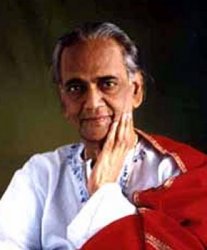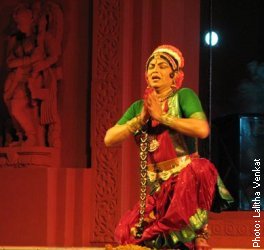
|
 |

|
 |
The feminine tradition of Andhra Natyam - Vijay Shanker, Mumbai e-mail: vijaydance@gmail.com July 27, 2012 Dr. Nataraj Ramakrishna had dedicated his life towards the promotion and propagation of Andhra Natyam but it is disheartening to note that this dance style has not received the recognition it truly deserves. The contribution of Andhras towards the enrichment of dance is remarkable. It would be no exaggeration to state that there is no musical or dance performance without a Telugu song. Andhra Natyam belongs to Andhra Pradesh and it enjoys a supreme place in the history of Indian dance. Known as the feminine tradition, it is more than two thousand years old and is enriched and embellished with bhava (expressions), raga (musical melody) and tala (rhythm). A combination of these three aspects can be called Bharatam, therefore Andhra Natyam can be called the Bharatanatyam of the Andhras. Unfortunately, Andhra Natyam does not enjoy international recognition like Bharatanatyam. Different names of Andhra Natyam Andhra Natyam is also known by other names like Agama Nartanam, Kelika, Darbar Ata, Kutcheri Ata, Karnatakam, Nattuvamelam, Meju Vani etc. Each name has a particular significance like the dance performed according to Agama Sastra is known as Agama Nartanam. Similarly, the dance performed for entertainment is called Kelika. The dance performed in the presence of gods in the Kalyana Mandapa or the courts of kings is called Darbar Ata. The dance performed according to traditional classical music is called Karnatakam. The dance performed with expert leadership of a female dancer is known as Nattuvamelam and the dance performed by expert scholarly female dancer is known as Meju Vani. More than 45 years earlier, all these names were prevalent until a series of meetings with scholars under the auspices of Andhra Pradesh Sangeet Natak Akademi put these names together and called it Andhra Natyam. Over the period of 2000 years, three distinct traditions developed known as Agama Nartanam, Asthana Nartanam and Prabandha Nartanam. Agama Nartanam The dance was performed as part of worship in marga style according to Agama Sastra and was dedicated to gods. The dancers were Deva Ganikas who performed in the presence of the main deity in the Natya Mandapa only. The Agama Nartanam which was performed in the presence of Lord Shiva was different from that performed in the presence of Lord Vishnu or the Ashta Dikpalakas (eight guards in the eight directions of the temple). Asthana Nartanam The dance is considered an intellectual feast as the dancer displays her command over dance and the Sastras. The dance is performed during festivals and changes according to the likes of the particular king. Prabandha Nartanam A combination of education and entertainment, this dance is based on Puranas and Vedanta, incorporating Parijatams, Kalapams and Bhagavatham for the benefit of the common folk. Andhra Natyam recital If the dancer is a male, he is expected to be attired in female disguise. The dancer enters the stage with a Kumba Harati (a flame on a pot) and performs a churnika (lyrics in praise of God). After Pushpanjali, she performs nritta (pure dance), nritya (pure dance and expressions) and abhinaya (drama) based on the compositions of Annamacharya, Kshetragna or Siddhendra Yogi. For that matter, Sattvika abhinaya (divine gestural language) is considered the highlight of Andhra Natyam. The dancer also sings while dancing, so it is compulsory for the dancer to learn classical music. If she is unable to sing, she is supposed to give lip movement according to the supporting artiste who would sing in the background. Dr. Nataraj Ramakrishna  Dr. Nataraj Ramakrishna was born in Bali in 1933 in a family of patrons and lovers of art but his father never desired that he should become a dancer. Nevertheless, Nataraj was determined to learn dance and during his search, he met renowned mentors like Meenakshisundaram Pillai, Vedanta Naidupeta Rajamma and Pendyale Satyabhama.  Kala Krishna He revived and enriched Andhra Natyam, which had almost gone into oblivion. He trained several students at his dance institution Nritya Niketan in Hyderabad and among his popular disciples are Kala Krishna (famous female impersonator), Perini Ramesh and Sanjay. Perini Ramesh dances the Perini Shiva Tandavam which is considered the fastest and most virile dance form of the tenth century, one of the dance forms, among others, revived by Dr. Nataraj. Author of several books, Dr. Nataraj won several awards including the Rajyalakshmi Award but the best reward for his untiring efforts would be the worldwide recognition of Andhra Natyam. Vijay Shanker is a Kuchipudi performer and teacher based in Mumbai. Comments * He was a great master of classical dance in India. Here is an interview of Guru Nataraja Ramakrishna. youtube.com/watch?v=-Mc2E16z2sM - Lakshmana Babu (2 Aug 2017) > Post your comments Please provide your name and email id when you use the Anonymous profile in the blog to post a comment. All appropriate comments posted with name & email id in the blog will also be featured in the site. |